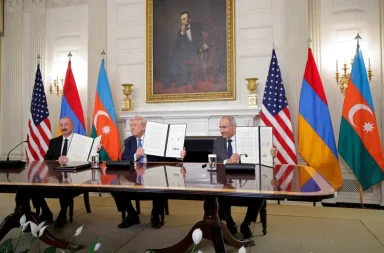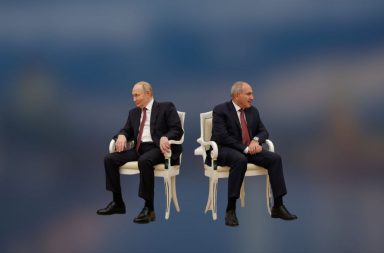by Davit Beglaryan
Moldova’s parliamentary elections on September 28, 2025, were a watershed moment. President Maia Sandu’s Party of Action and Solidarity (PAS) secured a majority with 50.2% of the vote, amidst heavy backing from Western states and organizations. Sandu’s alignment with the EU foreign policy establishment was the main purpose of her campaign, and the reason for intense interest in Moldova’s elections from EU-backed political organizations, which sought openly to influence the election in Sandu’s favor. Indeed, electoral influence operations were not limited to just foreign states, as the Moldovan court system also systematically impeded the opposition, banning opposition parties and blocking some opposition parties from participation in the elections. And of course, as has become now entirely predictable, all alternative narratives were systematically labeled as misinformation, disinformation, Russian propaganda, or any other justification for censoring the opposition.
With a claimed 51.9% turnout, the victory of the Western establishment was clear, even though the claimed results give them only a very narrow majority. This outcome was bolstered by diaspora voters from across Europe, who were openly favored by Moldovan authorities over potentially less controlled diaspora voters in Russia and Transnistria, who were instead faced with voter suppression tactics aimed at reducing their turnout. The multiple layers of electoral engineering, which were entirely predictable in today’s atmosphere of Democracy ideology in the West, offer warning signs for Armenia ahead of the 2026 parliamentary elections.
Western leaders hailed the outcome as a pro-European triumph, but the campaign revealed deep social divisions and exposed the selective nature of Western support for democracy.³ These lessons matter for Armenia, where parliamentary elections are scheduled for June 7, 2026. Nikol Pashinyan’s Civil Contract party enters this contest weakened, unpopular, and facing growing disillusionment at home, yet is determined to stay in power at all costs, with support from Western organizations that will undoubtedly seek to influence the Armenian elections as much as possible.
Societal Fractures and Pashinyan’s Divisive Rule
Moldova’s election highlighted sharp cultural divides. Though Moldova is a very small and economically impoverished country, it became the focus of intense interest in international affairs specifically because of its status as a testing ground for the broader Western campaign against Russia. The election was expressly framed in terms of a choice between the West and Russia, and it is a central part of Western strategy to coerce all former Soviet states into joining the anti-Russian confrontational policy of the West. NATO and EU expansion eastward depends on compliance from states such as Moldova. And this affects not only political organizations like the EU, but also the spread eastward of western social values and ideological narratives. Thus Moldova is a battleground state, a state targeted for absorption into the western ideological bloc. Armenia is another similar target.
Armenia’s political landscape is just as polarized as Moldova’s. Just like other battleground states in the new Cold War between West and East, Armenia features growing divisions between traditionally oriented people and proponents of “modernized” values. This is seen in many obvious ways, including the controversies surrounding the Armenian Church. This pattern is seen in various other countries that are torn between being absorbed by American-influenced ideology versus preserving their traditions. For example, Ukraine today is aggressively persecuting the Orthodox Church, in a maneuver seemingly copied directly by Pashinyan.
The Civil Contract party’s approval rating has sunk to 11–11.5%, driven by economic stagnation, territorial concessions in Artsakh, and public frustration with unfulfilled promises.⁷ The March 2025 Gyumri and Parakar municipal elections handed humiliating defeats to Pashinyan’s party,⁸ though the outcome of elections next year is far from clear.
Western Hypocrisy: Shielding Pashinyan’s Flaws?
The Moldovan elections underscored how Western governments often prioritize geopolitics over democratic standards. Despite OSCE reports of media bias and harassment of opposition parties, EU officials celebrated Sandu’s victory as a “win for democracy.”¹⁰ Western-backed NGOs also played a disproportionate role in bolstering PAS.¹¹
Armenia may face the same dynamic. Pashinyan’s pro-Western pivot—advancing a so-called peace deal with Azerbaijan, signaling a possible CSTO withdrawal, and strengthening ties with NATO—makes him useful to Europe and Washington.¹² Yet his government has suppressed protests, targeted critical media, and weaponized corruption investigations against rivals.¹³ These practices echo Sandu’s tactics, and Brussels may again look the other way.¹⁴ In fact, Brussels would not only look the other way at election irregularities, but rather would actively encourage them, just like in Moldova. Suppressing opposition is the new definition of “Democracy”.
No Faith in Pashinyan or Opposition
Despite Sandu’s clearly foreign-influenced election engineering and serious unpopularity in Moldova, many voters were similarly negatively inclined against the various opposition blocs such as Igor Dodon’s pro-Russian Patriotic Bloc. These opposition factions are often associated with corruption, and thus earned little trust among the broader electorate.
Armenians similarly distrust their former leaders. Robert Kocharyan and Serzh Sargsyan, the previous two presidents of Armenia before the premiership of Pashinyan, are attempting to regain their political power via the Armenian opposition, but are often associated with corruption and stagnation, with their Hayastan alliance and Republican Party unable to secure broader societal trust than Pashinyan. Yet Pashinyan still has only an 11% approval rating. Thus, it is clear that Armenians broadly dislike both the current authorities and many of the opposition alternatives. Pashinyan has delivered terrible trauma to the Armenian people with the loss of Artsakh, but what alternative Armenians will rally around remains to be seen.
New groups such as “#MerDzevov” have emerged, presenting themselves as defenders of sovereignty and tradition.¹⁸ While they attract some undecided voters, they lack a fully articulated economic and governance agenda, leaving uncertainty about their long-term viability. Independent coverage has noted that these movements blend genuine grassroots energy with recycled political figures.¹⁹
Opposition: Opportunities and Weaknesses
Armenia’s opposition has both strengths and weaknesses. On the one hand, it has gained momentum through local victories and discontent with Pashinyan.²⁰ On the other, fragmentation and rivalries limit its effectiveness. Multiple opposition parties often split the anti-government vote, diluting their collective strength.²¹
Compared with Moldova, where Dodon’s bloc became associated with “reverting to the past” and being “backwards-looking”, Armenian opposition faces a similar challenge to avoid being seen as simply “the old guard.” For now, opposition forces represent a potential alternative, but they will need unity and a forward-looking vision to transform public frustration into electoral success.²²
In the broader international relations context, Moldova was an arena of interest for Russia to try to restore some favorable position on the far western edge of the former USSR and the border with NATO, especially due to Russia’s presence in Transnistria. However, Moldova was always an uphill battle for pro-Russian political forces, as Moldova is currently surrounded by the EU/NATO on one side and Ukraine on the other, making anti-Russian informational operations far more advantageous.
In Armenia, on the other hand, Russia’s leverage is far stronger. There is a much stronger legacy of strong alliance between Russia and Armenia than with Moldova, and Armenia remains dependent on Russia for a very significant share of its economy. Therefore, an attempt by the West to tear Armenia away from its traditional Russian partnership may have far stronger consequences for Armenia than for Moldova.
Conclusion: Armenia’s Precarious Road to 2026
Moldova’s 2025 election revealed the risks of polarization, Western double standards, and international informational and propaganda operations determined to influence electoral results. Armenia now faces the same challenges, but with higher stakes given its fragile security situation.
Pashinyan is deeply unpopular, yet opposition forces remain fragmented and similarly unpopular. Without credible alternatives, Armenia risks sliding into further disillusionment. EU and US institutional support will undoubtedly work to uphold Pashinyan, but at the cost for Armenia of becoming a new vassal in the West’s anti-Russian campaign.
The lesson is clear: unless Armenia’s leaders in both the government and the opposition prioritize the sovereignty and genuine interests of the Armenian people, Armenia runs the risk of deepening its political and societal divisions in 2026.
Footnotes
- Reuters, “Moldova’s pro-EU party wins pivotal election in setback for Russia,” September 28, 2025.
- IFES, “Elections in the Republic of Moldova: 2025 Parliamentary Election,” September 2025.
- The Guardian, “Moldova’s election result bolsters move towards EU and away from Moscow,” September 29, 2025.
- Osservatorio Balcani e Caucaso Transeuropa, “Armenia: Political Tensions Mount as 2026 Elections Approach,” March 18, 2025.
- BBC, “Moldova’s pro-EU party wins vote mired in claims of Russian interference,” September 28, 2025.
- BBC, “Moldova holds key election as Russia’s shadow looms large,” September 28, 2025.
- RCSP, “Possible Models of the 2026 Parliamentary Election Results,” June 2025.
- EVN Report, “Municipal Elections: Opposition Wins in Parakar, Uncertainty in Gyumri,” April 20, 2025.
- OSCE, “Moldova, Parliamentary Elections, 28 September 2025: Interim Report,” September 30, 2025.
- Al Jazeera, “Moldova’s pro-EU party wins election hit by Russian interference claims,” September 28, 2025.
- RCSP, “Possible Models of the 2026 Parliamentary Election Results,” June 2025.
- CivilNet, “Armenia’s Local Elections: When the Government Influences the Outcomes,” April 15, 2025.
- Institute for the Study of War, “Russia Continues Efforts to Regain Influence over Moldova,” October 2025.
- IFES, “Elections in the Republic of Moldova: 2025 Parliamentary Election,” September 2025.
- JAMnews, “Kocharyan on Armenia’s 2026 Elections,” July 2, 2025.
- Azatutyun, “Serzh Sarkisian ‘Undecided’ About 2026 Elections,” June 1, 2025.
- PanARMENIAN.Net, “New Opposition Party Formed Ahead of 2026 Elections,” September 12, 2025.
- 301.am, “Critical coverage of Armenian opposition parties,” September 2025.
- Osservatorio Balcani e Caucaso Transeuropa, “Pashinyan Faces Gyumri Setback as Opposition Eyes 2026 Election,” April 1, 2025.
- The New York Times, “Russian Meddling Fails to Swing a Pivotal Election in Europe,” September 28, 2025.
- commonspace.eu, “Despite disillusionment, Pashinyan favourite to win crucial 2026 vote in Armenia,” September 15, 2025.


